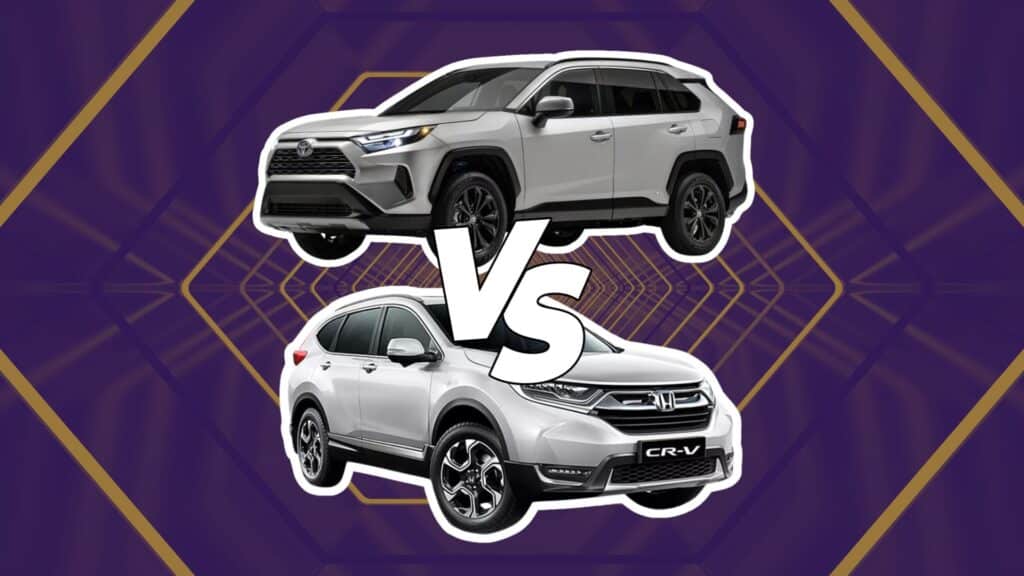Compact SUV shoppers often compare the Toyota RAV4 and Honda CR-V. Both vehicles are top picks in their class, but regarding safety, which is the leader?
Many drivers prioritize protection for themselves and their loved ones, making safety features a crucial factor in the decision-making process.
Fortunately, the RAV4 and CR-V are equipped with advanced safety technologies to prevent accidents and protect occupants.
However, some key differences between these popular models could sway your choice.
In this article, we’ll closely examine the safety features of the RAV4 vs CR-V, comparing their standard and available systems, crash test ratings, and overall safety credentials.
By the end, you’ll have a clear picture of which SUV might better meet your safety needs.
Overview of Toyota RAV4 and Honda CR-V
When comparing the RAV4 vs CR-V, it’s essential to understand each vehicle’s key features and characteristics.
Both are leaders in the compact SUV segment but have particular offerings that set them apart. Let’s take a closer look at each model.
The Toyota RAV4

The Toyota RAV4, now in its fifth generation, remains a top contender in the compact SUV market.
It offers a 2.5-liter four-cylinder engine with 203 horsepower and an eight-speed automatic transmission.
The RAV4 is available in both front-wheel and all-wheel drive options. Its interior comfortably seats five and features a user-friendly infotainment system.
Toyota offers various trims, from the base LE to the rugged TRD Off-Road, to cater to different preferences and needs.
The Honda CR-V

The Honda CR-V, recently redesigned for its sixth generation, is popular among compact SUV buyers.
It’s powered by a 1.5-liter turbocharged four-cylinder engine producing 190 horsepower and a continuously variable transmission (CVT).
The CR-V is known for its spacious and well-designed interior, offering plenty of passenger and cargo room.
Honda provides the CR-V in several trim levels, focusing on comfort and practicality. The vehicle’s reliability and fuel efficiency reputation make it a strong competitor in the RAV4 vs CR-V comparison.
Active Safety Technologies
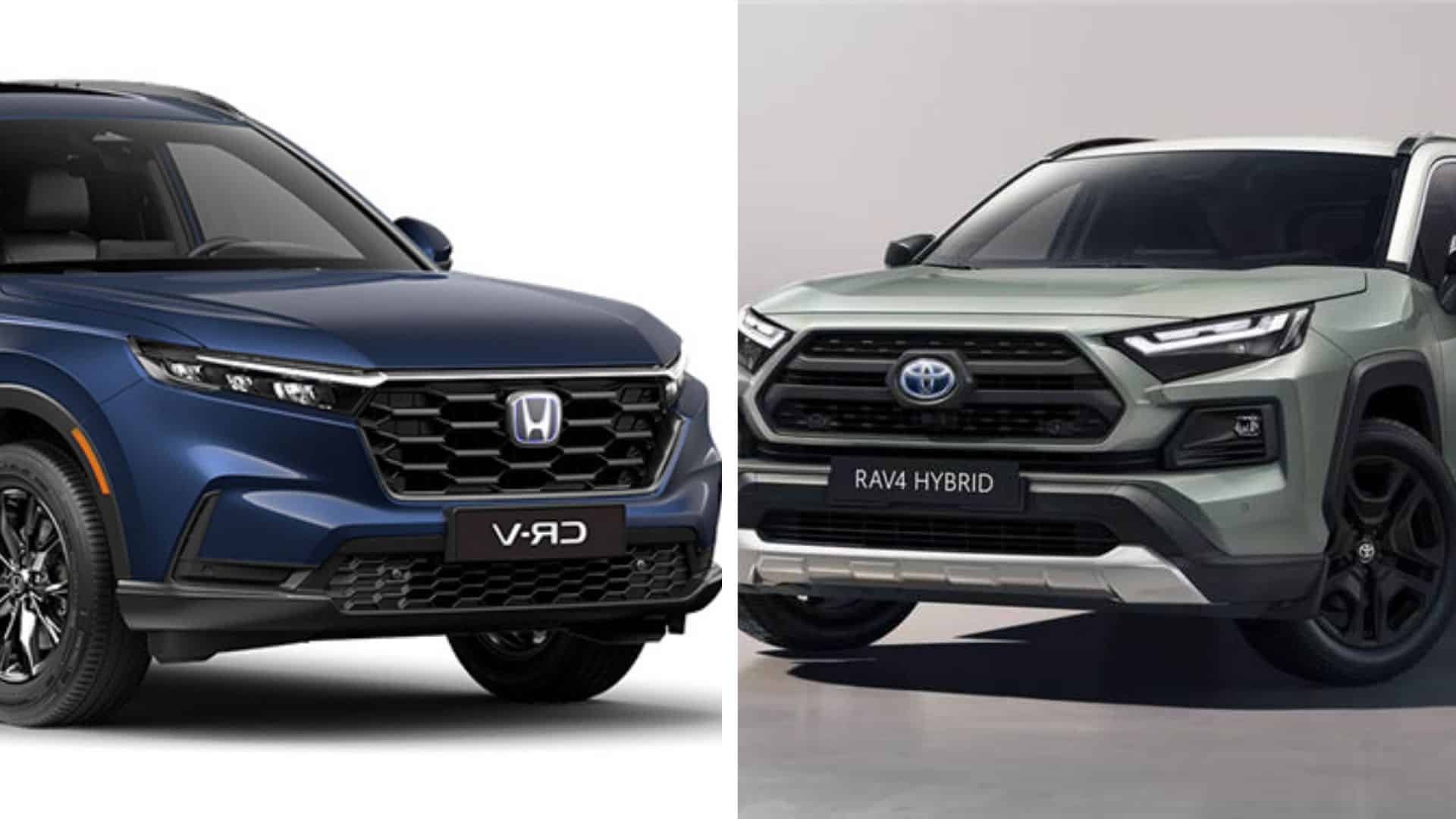
When comparing the RAV4 vs CR-V, examining their active safety features is crucial. Both vehicles come equipped with comprehensive suites of advanced driver assistance systems designed to prevent accidents and enhance overall safety on the road. Let’s break down the offerings from each manufacturer.
The Toyota RAV4
The RAV4 comes standard with Toyota Safety Sense™ 2.5 (TSS 2.5), which includes the following.
- Pre-Collision System with Pedestrian Detection (PCS w/PD): Helps detect vehicles, pedestrians, and cyclists, providing warnings and automatic braking if needed.
- Full-Speed Range Dynamic Radar Cruise Control (DRCC): Maintains a preset distance from the vehicle ahead, adjusting speed as necessary.
- Lane Departure Alert with Steering Assist (LDA w/SA): Alerts the driver if the vehicle drifts from its lane and can provide gentle steering correction.
- Lane Tracing Assist (LTA): Helps keep the vehicle centered in its lane, reducing driver fatigue on long trips.
- Automatic High Beams (AHB): Toggles between high and low beams automatically for better nighttime visibility.
- Road Sign Assist (RSA): Recognizes and displays certain road signs on the instrument panel.
- Enhanced Vehicle Stability Control (VSC): Helps prevent skids and loss of traction.
- Traction Control (TRAC): Reduces wheel spin on slippery surfaces.
- Anti-lock Brake System (ABS): Prevents wheel lockup during hard braking.
- Electronic Brake-force Distribution (EBD): Optimizes brake force for road conditions.
- Brake Assist (BA): Provides extra braking power in emergencies.
- Smart Stop Technology® (SST): Reduces engine power when the brake is firmly applied.
The Honda CR-V
The CR-V is equipped with Honda Sensing® Safety & Driver-Assistive Technologies, which includes.
- Collision Mitigation Braking System™ (CMBS™): Alerts the driver and can apply brake pressure to help avoid or reduce the severity of a collision.
- Adaptive Cruise Control (ACC) with Low-Speed Follow: Like Toyota’s DRCC, it maintains a set following distance and can operate in stop-and-go traffic.
- Lane Departure Warning (LDW): Alerts the driver if the vehicle drifts out of its lane without a turn signal.
- Lane Keeping Assist System (LKAS): Gently steers the vehicle to help keep it centered in the detected lane.
- Auto High-Beam Headlights: Automatically switches between high and low beams as needed.
- Traffic Sign Recognition System (TSR): Detects and displays road signs on the instrument panel.
- Vehicle Stability Assist™ (VSA®) with Traction Control: Helps maintain traction and stability in various driving conditions.
- Anti-Lock Braking System (ABS): Prevents wheel lockup during hard braking.
- Electronic Brake Distribution (EBD): Distributes braking force among the wheels based on driving conditions.
- Brake Assist: Provides full braking power in emergencies.
Both vehicles provide a strong collection of active safety features, with slight variations in naming conventions and specific functionalities.
These systems work together to help drivers avoid potential hazards and maintain control in various driving situations.
Passive Safety Systems
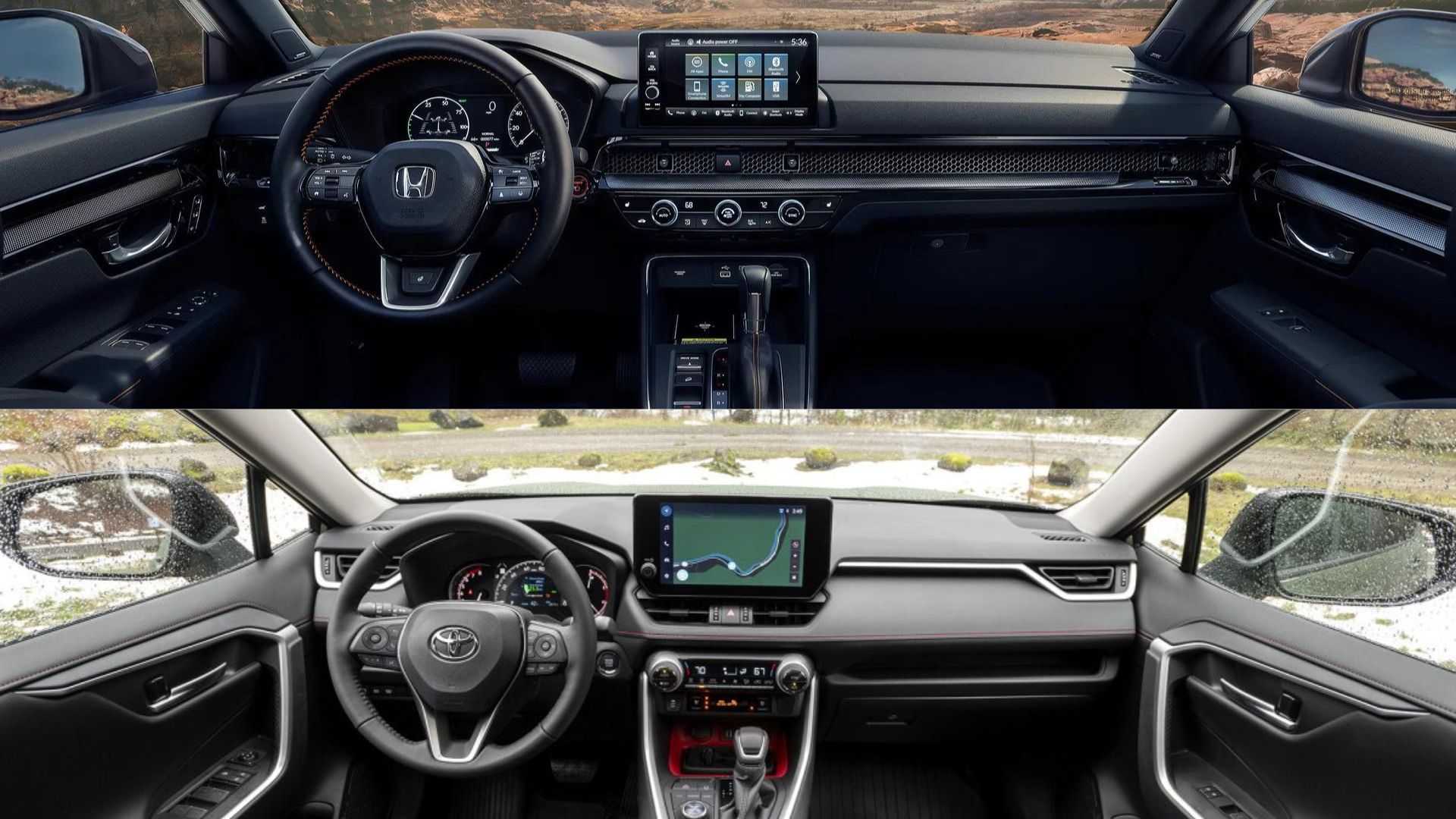
In the RAV4 vs CR-V comparison, passive safety features are crucial in protecting occupants during a collision. Let’s examine the passive safety systems offered by each vehicle.
The Toyota RAV4
The RAV4 comes equipped with a comprehensive airbag system, including eight airbags.
- Driver and front passenger advanced airbag system: Adjusts deployment force based on crash severity and occupant position.
- Seat-mounted side airbags: Provide torso protection in side impacts.
- Driver’s knee airbag: Helps reduce lower leg injuries for the driver.
- Front passenger seat cushion airbag: Helps prevent submarining under the seatbelt.
- Front and rear side curtain airbags: Offer head protection for all outboard occupants.
Additional passive safety features include.
- Hill Start Assist Control (HAC): Prevents rollback when starting on an incline.
- Downhill Assist Control (DAC) on select trims: Maintains a constant slow speed when descending steep grades.
- Backup camera with dynamic gridlines: Aids in reversing and parking maneuvers.
- Panoramic view monitor (available on TRD Off-Road and Limited trims): Provides a 360-degree view of the vehicle.
The Honda CR-V
The CR-V boasts an even more extensive airbag system, with ten airbags.
- Driver’s and front passenger’s advanced front airbags: Similar to the RAV4’s system.
- Knee airbags: Provide additional protection for both front occupants’ lower legs.
- Front side airbags: Offer torso protection in side impacts.
- Rear outboard passengers’ side airbags: Extend side impact protection to rear passengers.
- Side curtain airbags: Provide head protection for all outboard occupants.
Other passive safety features include.
- Hill Start Assist: Functions similarly to the RAV4’s HAC.
- Hill Descent Control on all trims: Available across the range, unlike the RAV4.
- Multi-angle rearview camera with dynamic guidelines: Offers multiple viewing angles for improved reversing visibility.
Both vehicles provide robust passive safety systems, with the CR-V offering slightly more airbag coverage.
However, the RAV4’s available panoramic view monitor on higher trims could benefit some drivers.
Driver-Assist Features
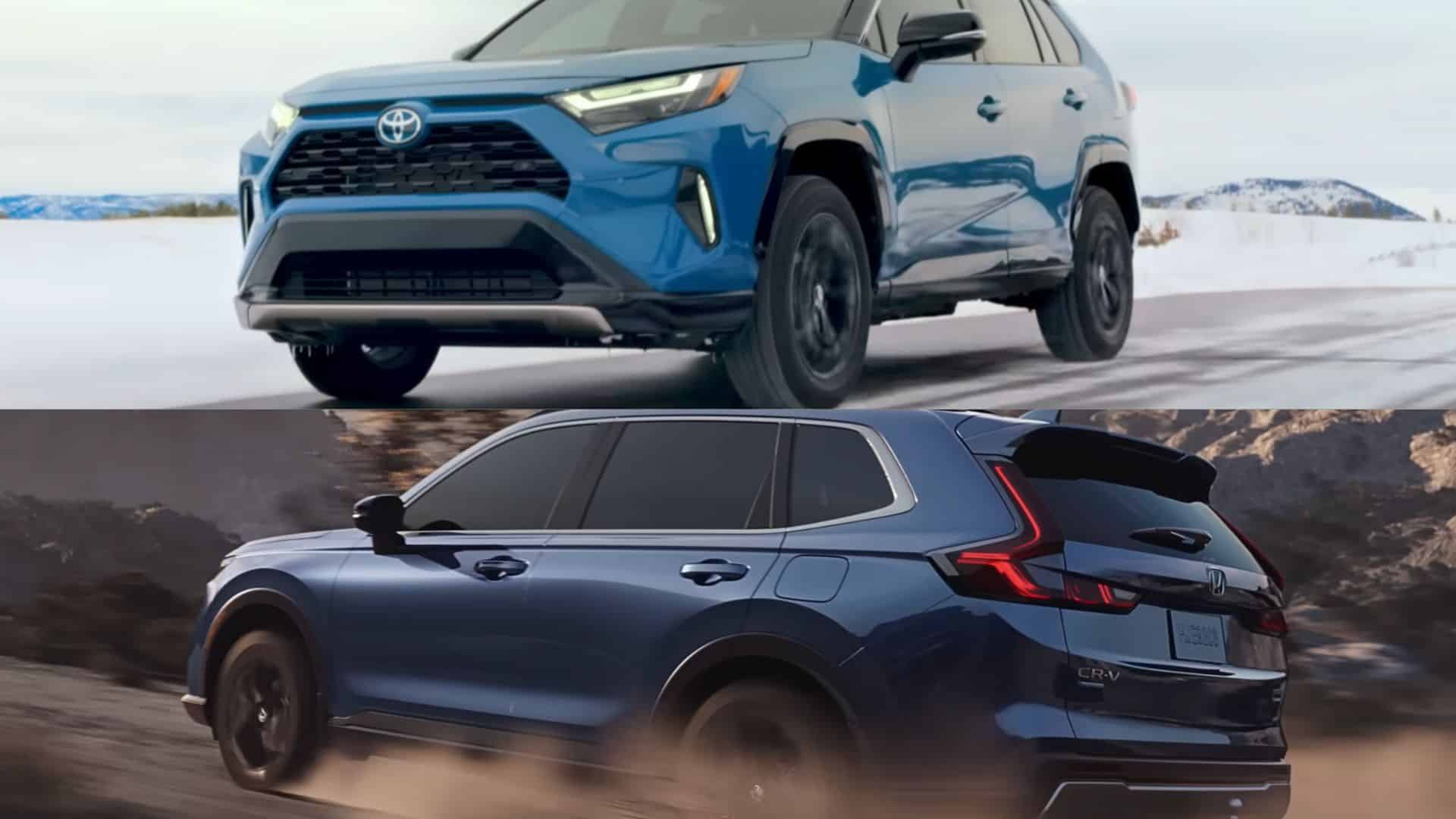
When comparing the RAV4 vs CR-V, it’s important to consider the driver-assist features that enhance convenience and safety.
Both vehicles offer a range of technologies, but there are some key differences.
The Toyota RAV4
- Blind Spot Monitor (BSM) with Rear Cross-Traffic Alert (RCTA): Available on all trims except the base LE, this system alerts drivers to vehicles in their blind spots and approaching from the sides when backing up.
- Smart Key System with Push Button Start: Standard on all trims except the base LE, allowing for keyless entry and engine start.
- Power liftgate: Standard on higher trims and optional on others, providing hands-free access to the cargo area.
- Remote Connect: This service offers a one-year trial (excluding LE trim) and allows users to interact remotely with their vehicle through a smartphone app.
- Wi-Fi Connect: Provides a 30-day/3GB trial, turning the RAV4 into a mobile hotspot.
- Safety Connect: Includes an Emergency Assistance Button, Enhanced Roadside Assistance, Automatic Collision Notification, and Stolen Vehicle Locator. Toyota offers an impressive up to 10-year trial for this service.
The Honda CR-V
- Blind Spot Information System (BSI) with Cross Traffic Monitor: This system, which functions similarly to Toyota’s, is available on all trims except the base LX.
- Remote Entry System with Push Button Start: Standard across all CR-V trims.
- Wireless phone charger: Standard on higher trims, allowing convenient device charging without cables.
- Wi-Fi hotspot capability: Exclusive to top trims, unlike the RAV4’s broader availability.
Both vehicles offer similar core driver-assist features, but the RAV4 seems to have an edge with its longer trial period for connected services and more widespread availability of Wi-Fi connectivity.
However, the CR-V’s standard wireless phone charger on higher trims could be a desirable feature for some users.
The choice between these two might be which specific features align best with an individual’s needs and preferences.
Warranty and Reliability
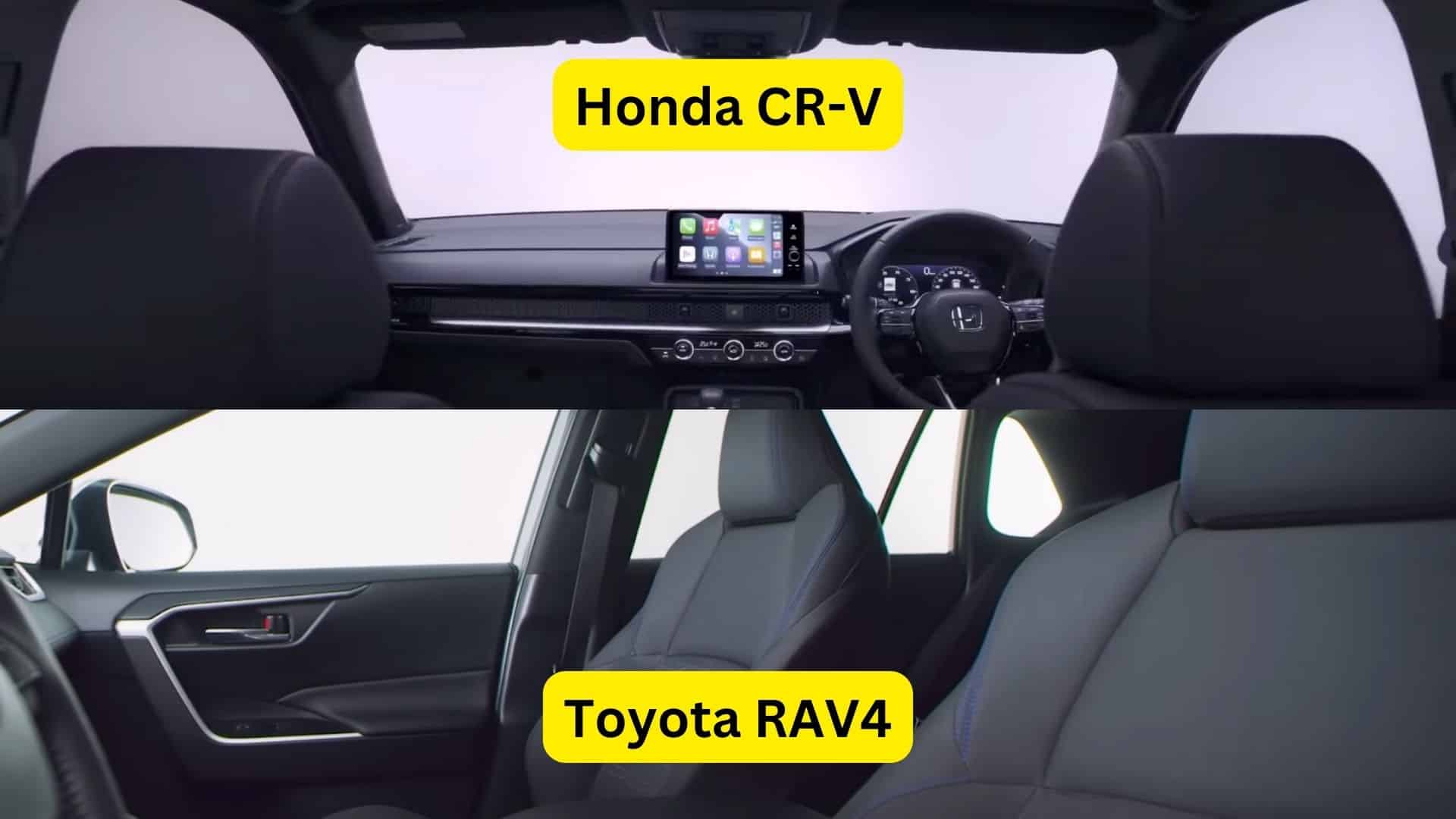
When comparing the RAV4 vs CR-V, warranty coverage and reliability are crucial factors.
Toyota and Honda offer competitive warranty packages, but some differences are worth noting.
The Toyota RAV4
- Basic Warranty: Covers 36 months or 36,000 miles, whichever comes first.
- Powertrain Warranty: Extends to 60 months or 60,000 miles, providing longer coverage for essential drivetrain components.
- Corrosion Perforation Warranty: Lasts for 60 months with unlimited miles, protecting against rust-through.
- Safety Connect: Offers up to 10 years of service, providing long-term access to safety and security features.
- ToyotaCare: Includes a 2-year or 25,000-mile maintenance plan, covering routine service at no additional cost.
The Honda CR-V
- Limited Warranty: Covers 36 months or 36,000 miles, matching Toyota’s basic coverage.
- Powertrain Warranty: It also extends to 60 months or 60,000 miles, which is on par with the RAV4.
- Corrosion Limited Warranty: Provides 60 months of coverage with unlimited miles, similar to Toyota’s offering.
- Complimentary factory-scheduled maintenance: Covers 2 years or 24,000 miles, slightly less than Toyota’s plan.
- 24-hour Roadside Assistance: Available during the Limited Warranty period (3 years/36,000 miles).
Both vehicles offer similar core warranty coverage, with the main differences in the additional services.
The RAV4’s ToyotaCare plan covers 1,000 miles of maintenance compared to Honda’s offering.
Additionally, the RAV4’s Safety Connect service, with its potential 10-year duration, stands out as a significant advantage.
Both the RAV4 and CR-V have strong reputations in terms of reliability. Toyota and Honda are known for building dependable vehicles, and these models are no exception.
However, specific reliability ratings can vary by model year and individual vehicle history.
Ultimately, while the warranty packages are similar, Toyota’s slightly more comprehensive maintenance plan and longer-term connected services might give the RAV4 a slight edge in this category.
Conclusion
Both vehicles are strong contenders in the safety features showdown between the RAV4 vs CR-V.
Each offers a comprehensive suite of active and passive safety technologies to protect occupants and prevent accidents.
While the CR-V boasts a few extra airbags, the RAV4 counters with longer-term connected services and a slightly more comprehensive maintenance plan.
Ultimately, your choice may come down to personal preference and specific needs. Toyota and Honda have built reputations for reliability and safety, making either SUV a solid pick for safety-conscious drivers.
Before deciding, we recommend test-driving both vehicles to understand their safety features.
Remember, the best safety feature is an alert, responsible driver. Regardless of the vehicle you choose, always prioritize safe driving habits.
Frequently Asked Questions
1. Does the Honda CR-V have safety features?
Yes, the Honda CR-V is equipped with numerous safety features. It includes the Honda Sensing suite, which offers technologies like Collision Mitigation Brakes, Adaptive Cruise Control, and Lane-Keeping Assist.
The CR-V also has multiple airbags and structural enhancements for occupant protection.
2. Which is more reliable, CR-V or RAV4?
Both the CR-V and RAV4 have strong reliability reputations. Toyota has historically led in reliability rankings, but Honda follows closely.
The difference is often minimal, and both vehicles are considered highly dependable choices in the compact SUV segment.
3. Where does the Honda CR-V rank for safety?
The Honda CR-V consistently ranks highly for safety. It has received top safety ratings from both the IIHS and NHTSA.
The CR-V’s combination of advanced driver assistance technologies and robust crash protection contribute to its strong safety performance in various tests.
4. Which is better, a Toyota or a Honda SUV?
Toyota and Honda produce excellent SUVs, and the choice often comes down to personal preference.
Toyota SUVs are known for reliability and resale value, while Honda SUVs often offer a sportier driving experience. Consider test-driving both to determine which better suits your needs.


